Page 10 of 17
Re: Cooling system
Posted: Mon Apr 07, 2008 6:44 pm
by Aethelric
I tried to simulate Grahame's traffic incident today. I drove around the town for a while but I could not get the temperature of the bottom hose to go up appreciably. So I parked and left the engine running. I had the aircon and the fans off to mimise heatloss through the heaters. After 25 mins the temperature was up to 50C and still going up but very slowly (about 1 degree per 90 seconds). I ran out of time. I think (hope maybe) that the temperature would have stabilised if I'd stayed there longer.
Dave
Re: Cooling system
Posted: Mon Apr 07, 2008 9:04 pm
by The Great Pretender
dandywarhol wrote:I don't think i'm confusing it TGP - the 1.5 deg per psi is only an approximation.
What I'm surprised at is the pressure on your gauge @4000 rpm is pretty close to the cap valve blow off pressure.
A 1.1 bar rad cap raises pressure by approx 16 psi. At 4000 rpm im seeing 20 to 24 psi.
Re: Cooling system
Posted: Mon Apr 07, 2008 9:09 pm
by The Great Pretender
Re: Cooling system
Posted: Mon Apr 07, 2008 9:51 pm
by Grahame at work
My differential temperature experiment 1
Method:
Using my now modified temperature monitor
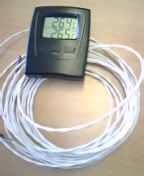
I fitted the two sensors like so:
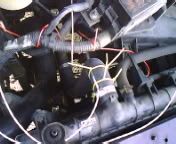
on the top hose to the engine
and
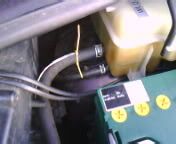
on the hose into the expansion tank
I only had time to ty-rap them on. I then drove home, just over 15mins. There is a fairly long hill 1/3 the way home with a couple of bends so I always use 'Hold' so I'm almost up to temperature by the time I get to the top. Then its back roads to home.
results:
The monitor+sensors worked fine. I got a steady increasing temperature on both - but always with the top hose reading being about 4 or 5 degrees higher.
When I pulled into my drive I was reading:
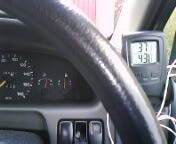
top reading is expansion tank hose / bottom reading top hose - there is 1 decimal place its just you can't see the dot
and
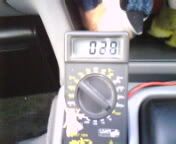
on the bottom hose thermocouple.
I let it idle for a bit over 5 mins until I got called in for my dinner

When I turned the engine off I was reading:
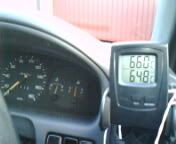
and
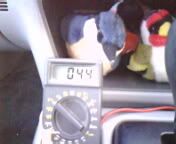
on the bottom hose.
Conclusion:
Interesting but inconclusive

I suspect that the expansion tank hose sensor was subjected to a cooling effect from the air blowing in under the bonnet as it is exposed far more than the top hose sensor, which is covered by the heater air intake cover (not in photos).
So tomorrow I try and protect the sensors more but I think that the expansion tank hose will always be subjected to greater cooling.
I have about 3m of cable on the sensors so I should be able to fit them anywhere on the cooling system. Anymore suggestions?
Regards Grahame
Re: Cooling system
Posted: Mon Apr 07, 2008 10:08 pm
by dandywarhol
The Great Pretender wrote:dandywarhol wrote:I don't think i'm confusing it TGP - the 1.5 deg per psi is only an approximation.
What I'm surprised at is the pressure on your gauge @4000 rpm is pretty close to the cap valve blow off pressure.
A 1.1 bar rad cap raises pressure by approx 16 psi. At 4000 rpm im seeing 20 to 24 psi.
.....so it can't be "feeling" the same pressure throughout the system - I was sure it would have the same pressure throughout a pressurised, sealed system..........

Re: Cooling system
Posted: Mon Apr 07, 2008 10:24 pm
by Grahame at work
I can understand the physics behind the pressure differential on a venturi and also Dandy's difficulty in considering a closed system.
So is the answer that there is sufficent other restrictions to the flow around the engine block, radiator and small bore hoses etc. (not forgetting the pump) that it can sustain such a relatively high differential pressure across one part of a closed system?

Grahame
Re: Cooling system
Posted: Mon Apr 07, 2008 10:28 pm
by The Great Pretender
Dont worry Dandy it's something that many cant get their head around, as I said before pressure changes with speed. A plane flies because of differential pressure above and below the wing caused by air having to move faster over the wing reducing pressure, the air under the wing (shorter distance to travel) is at a higher pressure so it pushes the plane up.
The stat on the outlet causes the restriction that allows the pump to provide the higher pressure behind it. As the coolant speeds up through the restriction the pressure is lost.

Re: Cooling system
Posted: Mon Apr 07, 2008 10:29 pm
by Aethelric
Great info Grahame - but it looks like I'm wrong about the flow through the radiator from one top hose to the other being a significant part of the cooling system. Any cooling in that path must be in the circuits after the degassing/header tank.
Does anyone know how the heater controls work? When they are turned down, then any of the following could happen
a. Coolant flow is reduced through the heaters so engine cooling is reduced
b. Coolant flow is not reduced but air flow over the heaters is reduced so engine cooling is reduced
c. Coolant flow is not reduced, the airflow over the heaters is not reduced, but the hot air is just vented to the outside world and cool air is pulled into the cab - engine cooling is not reduced (could even be enhanced!)
If c. is the case it may explain how the bongo can function reasonably well with a blocked radiator.
BTW when I got home this evening I left the engine running for a few minutes and checked the radiator fan. At a bottom hose temperature of around 35C it was switching on for about 3 seconds every 40 seconds.
TGP, I'll try that tomorrow.
Dave
Re: Cooling system
Posted: Mon Apr 07, 2008 10:32 pm
by The Great Pretender
Did my last post help Grahame?
Re: Cooling system
Posted: Mon Apr 07, 2008 10:40 pm
by Aethelric
Grahame at work wrote:I can understand the physics behind the pressure differential on a venturi and also Dandy's difficulty in considering a closed system.
So is the answer that there is sufficent other restrictions to the flow around the engine block, radiator and small bore hoses etc. (not forgetting the pump) that it can sustain such a relatively high differential pressure across one part of a closed system?

Grahame
There must be a pressure differential across a regulating thermostat or it would simply let all the coolant through without restriction. The way I picked it up is that TGP has moved his stat to the engine outlet and is measuring the pressure on the engine side of it. The excess pressure is generated by the pump. The rad and header are on the other side of the stat and therefore at a lower pressure.
Dave
Re: Cooling system
Posted: Mon Apr 07, 2008 10:49 pm
by The Great Pretender
Aethelric wrote:Grahame at work wrote:I can understand the physics behind the pressure differential on a venturi and also Dandy's difficulty in considering a closed system.
So is the answer that there is sufficent other restrictions to the flow around the engine block, radiator and small bore hoses etc. (not forgetting the pump) that it can sustain such a relatively high differential pressure across one part of a closed system?

Grahame
There must be a pressure differential across a regulating thermostat or it would simply let all the coolant through without restriction. The way I picked it up is that TGP has moved his stat to the engine outlet and is measuring the pressure on the engine side of it. The excess pressure is generated by the pump. The rad and header are on the other side of the stat and therefore at a lower pressure.
Dave



Re: Cooling system
Posted: Mon Apr 07, 2008 10:54 pm
by dandywarhol
Aethelric wrote:Great info Grahame - but it looks like I'm wrong about the flow through the radiator from one top hose to the other being a significant part of the cooling system. Any cooling in that path must be in the circuits after the degassing/header tank.
Does anyone know how the heater controls work? When they are turned down, then any of the following could happen
a. Coolant flow is reduced through the heaters so engine cooling is reduced
b. Coolant flow is not reduced but air flow over the heaters is reduced so engine cooling is reduced
c. Coolant flow is not reduced, the airflow over the heaters is not reduced, but the hot air is just vented to the outside world and cool air is pulled into the cab - engine cooling is not reduced (could even be enhanced!)
If c. is the case it may explain how the bongo can function reasonably well with a blocked radiator.
BTW when I got home this evening I left the engine running for a few minutes and checked the radiator fan. At a bottom hose temperature of around 35C it was switching on for about 3 seconds every 40 seconds.
TGP, I'll try that tomorrow.
Dave
It's "C" Dave............
Re: Cooling system
Posted: Mon Apr 07, 2008 11:01 pm
by Grahame at work
TGP - Yes I understand - so can we tell how much flow there is? to get the high pressure (relative) that you are getting and not reach the cap pressure on the 'downstream' side does this indicate a high rate of flow or a low rate of flow?
I shall have to go back to the begining of this thread and study it some more - I may be loosing the track

Aethelric - I don't think that the coolant flow through the heater matrix changes with the setting of the heater controls, its constant flow.
My fans did not come on when I got home and I left it idling - the mason gauge dropped back to about 60% when the temperature was showing 60 odd at my radiator sensors so I didn't expect them to come on.
But now I come to think of it I have heard a relay 'ticking' sometimes when I have got home after some runs - I did say to myself "wonder what that is - must check it out" but of course I never did! I don't think that the fans were running when I heard this - wouldn't have heard the relay would I?
Hmmmmm I must get my fan indicators wired up - I think this may be important.
Time for bed said Zebedee
I shall go and lie awake thinking of hot hoses

Grahame
Re: Cooling system
Posted: Mon Apr 07, 2008 11:11 pm
by dandywarhol
The heaters would give a little bit of "cooling" to the system as they radiate heat inside the van in the "hot" position Grahame..................

Re: Cooling system
Posted: Mon Apr 07, 2008 11:14 pm
by The Great Pretender
Grahame at work wrote:TGP - Yes I understand - so can we tell how much flow there is? to get the high pressure (relative) that you are getting and not reach the cap pressure on the 'downstream' side does this indicate a high rate of flow or a low rate of flow?
I shall have to go back to the begining of this thread and study it some more - I may be loosing the track

Grahame
The flow is the same throughout the system grasshopper, it is the speed that changes to alter the pressure. 



 top reading is expansion tank hose / bottom reading top hose - there is 1 decimal place its just you can't see the dot
top reading is expansion tank hose / bottom reading top hose - there is 1 decimal place its just you can't see the dot

